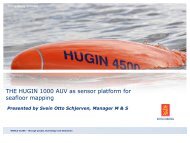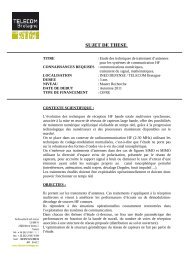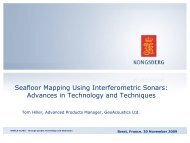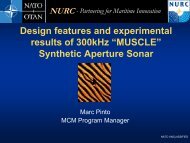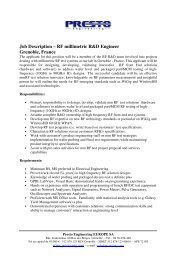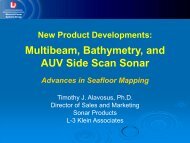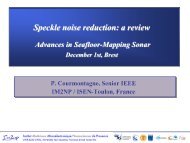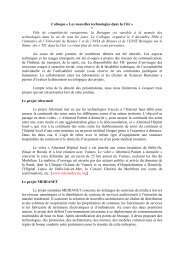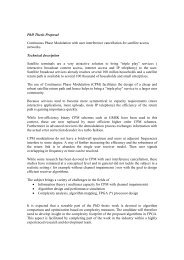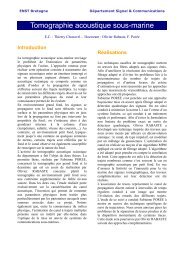Applications of n<strong>et</strong>works to transportsLocalization and Communication for emergency servicesResearch Staff : Jean-Marie Bonnin, Yvon-Marie Le Roux, Patrick Lassudrie-Duchesne, DanielBourreauKeywords : mobile n<strong>et</strong>works, geo-localization, geographical information systemsApplications : ITS, emergency services,Partners & Funding : with partial funding of Région Br<strong>et</strong>agneIntroductionIn case of an accident or a disaster occurringeither on the road, in a factory, in a city, in aharbor or on a boat cruising close to the coast,three points are of the highest importance: therapidity of the intervention of the brigade, theexactness, the compl<strong>et</strong>eness and the topicalityof the critical information available at the levelof the headquarter vehicle and the possibilityfor intervening agents to remain in permanentcontact with that vehicle.The LoCoss project (Localisation <strong>et</strong>Communication pour les Services de Secours)deals with geo-localization, geographicalinformation systems and wirelesscommunication applied to disaster responsemanagement and coordination. LoCoSS aimsat bringing significant improvements to therescue brigades operations, terrestrial as wellas maritime. The project includes severaldepartments of Pracom (RSM, MO, ELEC) andseveral partners, École Navale, ENSIETA, LCPCNantes, Véhipôle Saint Brieuc. It is a 3-yearproject, which is funded by Region Br<strong>et</strong>agneand which started on April 2006.trace their movements from the vehicle and tooptimize operations management and thesecurity of the persons. Since all pieces ofequipment (in vehicles and on members of th<strong>et</strong>eam) will be provided with a full IPv6connectivity, the commanding vehicle or theheadquarter will be allowed to directly requestinformation from them.We made an in-depth study of the needsexpressed by the rescue services that areinvolved in the project as client of the solutionsand as experimenters. We identified severalpoints that have to be developed in order toimprove the viability of such a solution forcritical missions. One of the strongrequirements is the ability to give a priority tothe flows depending on the relative importanceof the data exchanged. It is also necessary toincrease the availably of the n<strong>et</strong>work service,when one vehicle is out of range for all accessn<strong>et</strong>works, it is needed to provide it with IPconnectivity through another truck acting as arelay.N<strong>et</strong>works aspectsThe RSM team is involved in the n<strong>et</strong>workingaspect of this project. Many wirelesscommunication technologies standards (GPRS,Wi-Fi, WiMAX, DSRC, UMTS…) could be usedto offer a permanent IPv6 connectivity toonboard equipments through NEMOtechnology (N<strong>et</strong>work mobility) and adequateinterface selection mechanism. Therefore, thecommanding vehicle is able to downloadcontinuously the necessary information into itslocal database, before the departure, during itstravel and during the operation. Wirelessduplex links will also be established b<strong>et</strong>weenthe vehicle and some members of the teamequipped with a positioning pack, in order to62 Pracom’s Annual Report <strong>2008</strong>
Geo-localization aspectsThanks to the positioning technologies, basedon EGNOS, aided by additional sensors toensure a high level of integrity, the interveningvehicles will be able to navigate precisely andaccurately up to the accident or disasterlocation and the main stationary headquarters(typically the fire station) will be informedprecisely about their progress. For the difficultissue of tracking the firemen inside a big sitesuch as a factory of a ship, novel positioningtechniques such as high-sensitivity or assistedGPS receivers, combined with inertial sensorsand 3D map-matching will be developed andexperimented.As far as research on positioning is concerned,partner ENSIETA is presently investigatingdifferent positioning technologies that could beutilized for the challenging indoor navigation.The basic idea is to combine severaltechnologies: high-sensitivity GNSS receiversfor the areas where GNSS signals arepen<strong>et</strong>rating, MEMS inertial measurement unitsfor the traveled distance based upon thenumber and size of steps, the directionprovided by the gyros and magn<strong>et</strong>om<strong>et</strong>ers andadvanced map-matching algorithms basedupon the 2D or 3D map of the area and th<strong>et</strong>opological constraints (1). First results fromthe LoCoSS project concern the firemenlocalization in constrained environment (forest,indoor, city…) where GPS position is notprecise enough. TELECOM Br<strong>et</strong>agneinvestigates also tog<strong>et</strong>her with ENSIETAtechnical m<strong>et</strong>hods to improve localizationaccuracy within multipath environments.Geographical InformationSystem aspectsFinally, on top of the geolocalisation andcommunication infrastructure, a GeographicalInformation System (GIS) will act ascomputing software able to integrate, store,model, analyze and visualize spatially relateddata. The information system of the LoCoSSproject will be used to build and to update anon-board database limited to the necessaryinformation to support the operations in agiven area. This “mobile database” will have tobe extracted from the main one at securityheadquarters. Similarly, the main databaselocated at the fire station will have to beinteractively updated in real-time during theprogress of the rescue operations. Amongstthe interesting dynamic data to integratewithin databases are firemen and vehiclespositions and movements. The continuousrecording of such data is essential for real-timefollowing of actual operations. These studiesare mainly covered by IRENAV from ÉcoleNavale.ConclusionThe project will develop mechanisms toacquire the real-time data coming from thegeo-localized vehicles and people through thewireless communication links and to stor<strong>et</strong>hem in an appropriate database. Spatiotemporalqueries to database will be developedto handle and display these dynamic data onthe existing firemen’s interface. Overallobjective will be to visualize the progress ofthe deployed forces and to make decisions inreal-time thanks to the global view of thesituation. A prototype system is planned to bebuilt next two years to demonstrate with thepartnership of fire brigades of Côtes d’Armorand Finistère departments the efficiency of theproposed security services.References[1] L. Suciu, J.-M. Bonnin, K. Guillouard,and T. Ernst. Multiple N<strong>et</strong>work InterfacesManagement for Mobile Routers. In 5thInternational Conference on ITSTelecommunications (ITST 2005), Brest,France, June 2005.[2] M. Mahamat-faki, J.-M. Bonnin, and R.Ben Rayana. Traffic flow control on multitunneledmobile router. In short paper inWNEPT06 (Workshop on N<strong>et</strong>working in PublicTransport), Waterloo, Canada, August 2006.[3] Patrick Bosc, Olivier Sentieys, FrançoisPeyr<strong>et</strong>, Cyril Ray, Jean-Marie Bonnin, Yvon-Marie Le Roux. GIS ITS Br<strong>et</strong>agne: status andperspectives, 6th International Conference onITS Telecommunications, Chengdu, China, 21-23 June, 2006.[4] R. Garello, Y. Le Roux, G. Landrac, C.Claramunt, R. Person, F. Vallée. GalileOcean,6th International Conference on ITSTelecommunications, Chengdu, China, 21-23June, 2006.Pracom’s Annual Report <strong>2008</strong> 63



